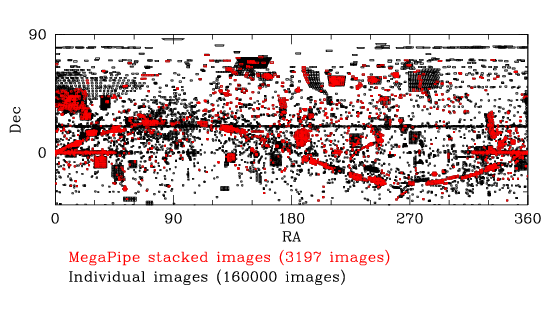Introduction to MegaPipe
Motivation
MegaPipe is a MegaCam image stacking pipeline. It takes multiple MegaCam images of a patch of sky, calibrates them, combines them into a single image and extracts a source catalogue. If input images in different filters are available for the same pointing, the resulting images are aligned to each other.
The biggest barrier to using archival MegaCam images is the effort required to process them. While the individual images are occasionally useful by themselves, more often the original scientific program called for multiple exposures on the same field in order to build up depth and get rid of image defects. Therefore, the images must be combined.
A typical program calls for 5 or more exposures on a single field. Each MegaCam image is about 0.7Gb (in 16-bit integer format), making image retrieval over the web tedious. Because of the distortion of the MegaPrime focal plane, the images must be resampled. This involves substantial computational demands. During this processing, which is often done in a 32-bit format, copies of the images must be made, increasing the disk usage. In summary, the demands in terms of CPU and storage are non-trivial. While, in ten years, Moore's law will presumably make these concerns negligible, if not laughable, at the moment they present a technological barrier to easy use of MegaCam data.
The Elixir pipeline at CFHT processes each MegaCam image. It does an excellent job of detrending (bias-subtracting, flat-fielding) the images. However, the astrometric solution Elixir provides is only good to about 1 arcsecond. To combine the images, they must be aligned to better than a pixel. One arcsecond accuracy is insufficient. Therefore, it is necessary for a user to devise some way of aligning the images to higher accuracy. This is not an easy task, and rendered more difficult by the distortion of the MegaPrime focal plane. The problem is not intractable and there do exist a number of software solutions to the problem, but it remains an obstacle to easy use of MegaCam data.
In short, while the barriers to using archival MegaCam data are not insurmountable, they render using these data considerably less attractive. MegaPipe aims to increase usage of MegaCam data by removing these barriers.
Goal and Scope
The goal of the MegaPipe project is to combine all publicly available MegaCam images, from both PI programs and the CFHTLS, into stacks and extract catalogues. Since the input data is publicly available, the output is also public.
The data will be grouped in one square degree chunks, the size of a single MegaCam image. The most usual way of taking MegaCam data is to take multiple exposures at each pointing, with a dither pattern that is a small fraction of a degree. Some projects involve staggered images which only overlap slightly; this would require making mosaics larger than a degree. The resulting images files would be over the 2Gb limit intrinsic to 32-bit computers, making them intractably large for many users. The other option is to work on a chip-by-chip basis. This has technical advantages: the image files are smaller and, in the case of glitches in the stacking procedure, jobs can be restarted with a smaller loss of time. It also has scientific advantages: some lensing studies require following the PSF from each chip of the input image to the stacked image, a task rendered much easier, if the stacked image only contains data from a single chip. However, the large dither pattern used in many projects precludes this approach. Too much data would be lost in the "gutters" between images. Also, the monolithic method means that there are a factor of 36 fewer files to deal with, simplifying some aspects of the stacking process.
While MegaPipe is primarially built for processing public data, PI data is processed on request. Please contact the CADC.
There will be updates about every six months. As data becomes publicly available, it will be processed through the MegaPipe pipeline. In principle, this could be done on a daily basis, as the pipeline requires only minimal supervision. However, a substantial fraction of CFHT data is obtained during queue observing. These data become public one year after the end of the six month semester in which they are taken. This means that, in practice, it is more useful to produce updates semi-annually.
Definitions
- A CCD or chip refers to a single 2k by 4k extension of a MegaCam multi-extension FITS file.
- An image or an exposure refers to the set of 36 MegaCam CCDs represented as a multi-extension FITS file.
- A stack is the aggregate of several exposures combined (added/averaged/medianed) together. Stacks are simple FITS file with dimensions around 20k by 20k
- A group is a set of several stacks, each in a separate passband, covering the exact same field.
Currently, the MegaPipe results include over 3000 groups. The coverage
is shown in the following figure. The individual MegaCam exposures are
shown in black. The stacked images are shown in red.

- Date modified: